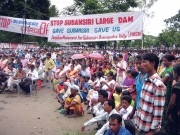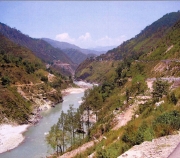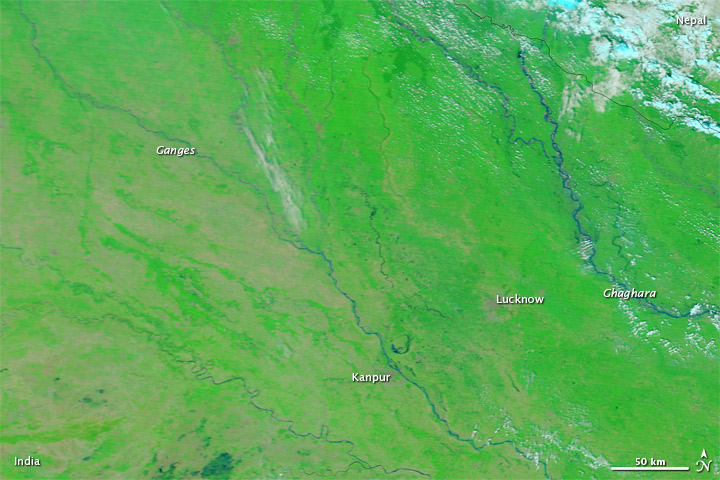Ganga
Eastern Himalaya freshwater biodiversity assessment report released by IUCN and Zoo Outreach Organisation
Posted on 18 Jan, 2011 11:44 PMDear all,
IUCN, with Zoo Outreach Organisation, have today published a new report, 'The status and distribution of freshwater biodiversity in the Eastern Himalaya', which is available online here
Damming North East India - Juggernaut of hydropower projects threatens social and environmental security of region
Posted on 28 Dec, 2010 07:49 PM This report by Kalpavriksh, Aaranyak and ActionAid India deals with the large dams’ juggernaut, which happens to be the biggest ‘development’ intervention in this ecologically and geologically fragile, seismically active and culturally sensitive region in the coming days. With the Northeast identified as India’s ‘future powerhouse’ and at least 168 large hydroelectric projects set to majorly alter the riverscape, large dams are emerging as a major issue of conflict in the region.
This report by Kalpavriksh, Aaranyak and ActionAid India deals with the large dams’ juggernaut, which happens to be the biggest ‘development’ intervention in this ecologically and geologically fragile, seismically active and culturally sensitive region in the coming days. With the Northeast identified as India’s ‘future powerhouse’ and at least 168 large hydroelectric projects set to majorly alter the riverscape, large dams are emerging as a major issue of conflict in the region.
Although the current scale of dam-related developments far outstrips anything which took place in the past, the region has been no stranger to dam-related conflicts. For example, the Kaptai dam, built in the Chittagong Hill Tracts of East Pakistan (now Bangladesh) in the 1960s, submerged the traditional homelands of the Hajong and Chakma indigenous communities, and forced them to migrate into parts of Northeast India.
Assessment of the status of environment and forest clearances of hydropower projects on river Mandakini – A report by MoEF
Posted on 27 Dec, 2010 02:08 PM This report by MoEF regarding the environmental impact of Phata-Byung & Singoli-Bhatwari hydro power projects on the river Mandakini deals with the additional safeguards and proper monitoring & supervision to help protect the environment in these project areas. It says that since a fairly large portion of the works has been taken up it may not be worth to abandon the project. It has proposed certain remedial measures to mitigate the damage if caused to the environment and local villagers.
This report by MoEF regarding the environmental impact of Phata-Byung & Singoli-Bhatwari hydro power projects on the river Mandakini deals with the additional safeguards and proper monitoring & supervision to help protect the environment in these project areas. It says that since a fairly large portion of the works has been taken up it may not be worth to abandon the project. It has proposed certain remedial measures to mitigate the damage if caused to the environment and local villagers.
The Phata-Byung and Singoli-Bhatwari hydro power projects, are Run of the River (RoR) projects on the river Mandakini. The series of RoR projects proposed and under construction as a part of cascade development are to generate electrical energy which is considered to be clean power as it is non-polluting and renewable in nature.
Himalayi Jan Goshnapatra: Himalayi Niti Ka Prarup – A report in Hindi by the Gandhi Peace Foundation
Posted on 18 Dec, 2010 08:19 AMThis document in Hindi prepared by the Gandhi Peace Foundation, is a blueprint of the Himalayan People's Manifesto. The manifesto has been brought out with the help of various documents prepared by various people and organisations at different times. It will be finalised by the next Himalayan Day on September 9, 2011.
Flooding in Northern India: Updates from Earth Observatory
Posted on 28 Sep, 2010 02:16 PMHeavy monsoon rains had pushed the Ganges and other rivers over their banks by late September 2010. The flooding left at least 2 million people homeless in northern India, Reuters reported. Some 500,000 hectares (1.25 million acres) of agricultural land were also flooded. Authorities reported that the Ganges and its tributaries had risen to near record levels, and meteorologists forecast more rains in the days ahead.

The encroaching Ganga and social conflicts: The case of West Bengal
Posted on 01 Aug, 2010 01:39 AMThis report deals with the social conflicts emerging out of the encroachments owing to the change in course of the Ganga upstream and downstream of the Farakka barrage. The barrage was built with the intention of diverting water into the Hugli river with a view to flush the sediment load into the deeper part of the estuary and revive the navigational status of Kolkata port. During the last three decades of its operation, the silt-management in the barrage was given scant or no attention. The sediment movement in the tidal estuary of Hugli is a function of a complex fluvial system that can hardly be governed by inducing 40000 cusec of water.
Dr. G. D. Agrawal , the scientist, environmentalist and rishi
Posted on 27 Jul, 2010 03:52 PMDr. G. D. Agrawal Scientist and Rishi
Meeting Dr. G. D. Agrawal in his spartan, two room cottage in Chitrakoot, Madhya Pradesh, you would never guess what an accomplished and distinguished scientist he is – first Member-Secretary of the Government of India’s Central Pollution Control Board, former Head of the Department of Civil and Environmental Engineering at IIT Kanpur and a PhD from the University of California, Berkeley. The list goes on and on.
Yet this eminent professional sweeps his own floors, washes his own clothes and cooks his own meals. He retains only a few possessions and dresses in homespun khadi. At the age of 76, his main mode of transport within Chitrakoot is a bicycle and when he travels further afield, he goes by ordinary bus and second-class train. These are the deliberate choices of a devout Hindu whose deepest values are for simplicity and reverence for nature. Dr G.D. Agrawal is the doyen of environmental engineering professionals in India. Well past retirement, he continues to teach and inspire students as an Honorary Professor of Environmental Sciences at the Mahatma Gandhi Chitrakoot Gramodaya Vishwavidyalaya, in Chitrakoot (M.P.).
Prof G.D. Agrawal resumes fast unto death to save the Ganga, Swami Avimukteshwaranand and others to join in support
Posted on 21 Jul, 2010 11:10 AMForwarded to the Portal by: Ayan Biswas
Image and News Courtesy:
Shankracharya designate Swami Avimukteshwaranand ji presided over an emergency meeting organized by Manushi Sangathan, Ganga Ahvaan and Ganga Yamuna Jal Biradri to express our strong protest against the patently illegal decision of the Group of Ministers giving clearance to the Loharinag-Pala dam on the Ganga River. The following expert members of the NGRBA also participated in the meeting to express their strong protest having been kept in the dark about the appointment of the GoM which has passed a virtual death sentence on the most sacred river of India: Rashid Hyatt Siddiqui, Rajendra Singh, Rama Raota and Ravi Chopra.
Development of regional flood formulae using L-moments for middle Ganga plains – A research report by National Institute of Hydrology
Posted on 21 Jun, 2010 04:45 PMThe study develops regional flood frequency relationship and flood formulae based on recently developed efficient techniques of flood frequency analysis to estimate floods of desired return periods for small to moderate size gauged and ungauged catchments of the middle Ganga plains (sub-zone 1F) encompassing parts of Uttar Pradesh, Bihar and West Bengal. A regional flood formula has been developed by coupling the L-moment based regional flood frequency relationship with the regional relationship between mean annual peak flood and the catchment area.
Snow cover estimation in Himalayan basins using remote sensing: A research report by National Institute of Hydrology
Posted on 21 Jun, 2010 04:37 PMThe study estimates the snow cover area for four major basins in the Himalayan region viz. Chenab up to Akhnoor, Ganga up to Devprayag, Satluj up to Bhakra and Beas up to Pandoh using IRS - IC and ID WiFS data. Snow cover estimation was done for the years 1997-2000 using image processing system ERDAS Imagine. The maximum and minimum snow cover extent for the month of September-October and March-April were delineated and on the basis of these the depletion curves for each basin was made for the four years. This output is useful for carrying out snowmelt runoff modeling.